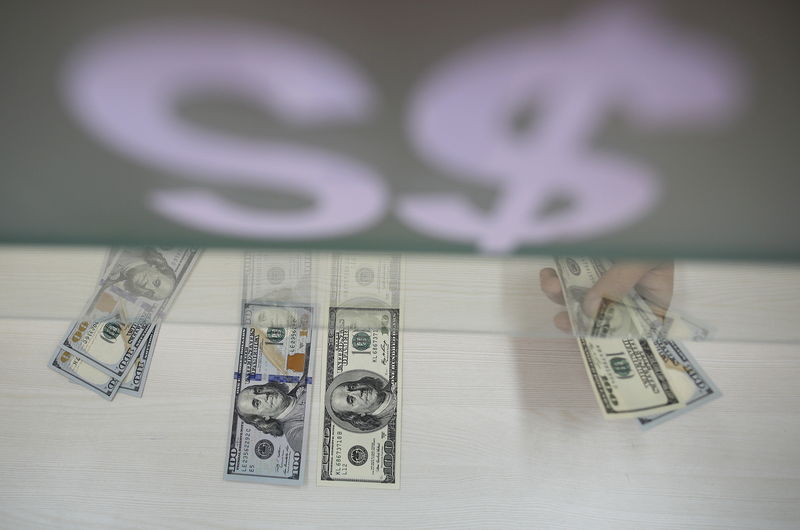* KRW and TWD hurt by technology rout
* Indonesian rupiah leads intraday declines
(Adds text, updates prices)
By Ambar Warrick
June 13 (Reuters) - Most Asian currencies were weaker on
Thursday, with a deteriorating outlook for the global memory
chip industry hurting the South Korean won and Taiwan dollar.
Regional risk appetite waned as chances of a U.S.-China
trade deal being struck at the G20 leaders' meeting in Osaka in
late-June grew less likely.
Emerging market currencies made little headway against the
dollar on Thursday despite moderate U.S. inflation data that
enhanced rate cut expectations by the Federal Reserve. The
dollar .DXY held the bulk of its overnight gains on safe-haven
demand. USD/
The Japanese yen JPY= was also up about 0.12%.
U.S. President Donald Trump declined to set a deadline on
Wednesday for levying further tariffs on Chinese goods and
called the relationship with Beijing good but "testy" after
China walked back commitments for a trade deal. "Risk appetite remains soft amid concerns on global growth
and a protracted trade war on the back of tough rhetoric from
Trump towards the U.S.' trading partners," Mizuho Bank's Zhu
Huani said in a note.
The won KRW=KFTC declined 0.24% to the dollar, while the
Taiwan dollar TWD=TP shed about 0.22%. Chipmaker stocks across
both regions declined after a report published by Evercore ISI
on U.S. chip equipment maker Lam Research LRCX.O spelt further
weakness in the industry. The Indonesian rupiah IDR=ID led intraday losses, falling
about 0.28% to the dollar. While sentiment for the rupiah has
improved recently due to political stability in the archipelago,
the currency stands to weaken if changes in global trade flows
adversely affect Indonesia's current account balance.
"Coupled with continued concerns on trade and current
account outlook, (the) rupiah could find it harder to gain
ground, despite dissipated political uncertainty and rising
consumer confidence," Saktiandi Supaat, head of FX research at
Maybank Singapore, said in a note.
The Chinese yuan CNY=CFXS edged about 0.02% lower to the
dollar, with further losses being mitigated by a stronger than
expected midpoint. The currency has seen stronger daily fixes of
late as it nears the crucial 7 per dollar level.
WEAKEST REGIONAL CURRENCIES
The won is the worst regional performer this year, dropping
about 5.9%, while the Taiwan dollar is the second-worst, having
shed about 2.4%.
Taiwan and South Korea rely heavily on electronics exports,
and a recent slowdown in the global technology industry has
dampened business conditions in both economies.
Taiwan cut its 2019 GDP outlook last month due to a drop in
exports, while South Korea revised lower its first-quarter GDP
figures last week. Sustained weakness in both economies will likely prompt
future policy easing.
The following table shows rates for Asian currencies against
the dollar on Thursday.
CURRENCIES VS U.S. DOLLAR
Change on the day at 0450 GMT
Currency Latest bid Previous day Pct Move
Japan yen 108.360 108.49 +0.12
Sing dlr 1.366 1.3666 +0.03
Taiwan dlr 31.500 31.430 -0.22
Korean won 1185.400 1182.6 -0.24
Baht 31.210 31.24 +0.10
Peso 51.950 51.99 +0.08
Rupiah 14270.000 14230 -0.28
Rupee 69.350 69.34 -0.01
Ringgit 4.160 4.155 -0.12
Yuan 6.921 6.9188 -0.02
Change so far in 2019
Currency Latest bid End 2018 Pct Move
Japan yen 108.360 109.56 +1.11
Sing dlr 1.366 1.3627 -0.26
Taiwan dlr 31.500 30.733 -2.43
Korean won 1185.400 1115.70 -5.88
Baht 31.210 32.55 +4.29
Peso 51.950 52.47 +1.00
Rupiah 14270.000 14375 +0.74
Rupee 69.350 69.77 +0.61
Ringgit 4.160 4.1300 -0.72
Yuan 6.921 6.8730 -0.69
